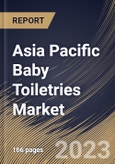Various companies launch new innovative products to increase their customer base. For instance, Johnson's Baby has a product called Johnson's Baby Cologne, which has a gentle, fresh fragrance, is clinically proven, contains a combination of floral and citrus hints, and is alcohol-free. These innovations help companies expand their portfolio and attract customers to purchase their products, increasing growth.
The demand for baby toiletries is increasing due to the increasing demand for protective baby care products. Parents are choosing products that are clean, labelled, and natural. Owing to this, the market players are launching natural baby care products. The demand for organic baby care products is increasing among parents as their awareness about harmful synthetic chemicals in baby care products is increasing. Organic baby care products like skincare products, diapers, and other products are growing among consumers. Due to rising disposable income, high-quality and environmentally friendly baby care products are preferred by parents. The market players are innovating new diapers using organic and soft fabric and organic ingredients. Because of environmental conditions like UV radiation, desert areas, dry environments, and many more, babies in those regions get affected easily as babies' skin is sensitive.
According to the data given by the State Council of China, the total count of infants in 2021 was 10.62 million, exhibiting a birth rate of 7.52 thousandths. With its large population, China has seen a consistent or increasing birth rate in recent years. The growing number of infants directly contributes to the expanding consumer base for baby toiletries, creating a significant market demand. Rapid urbanization in China has led to changes in lifestyle and consumer behaviour. The aforementioned factors will drive the market growth in this region.
The China market dominated the Asia Pacific Baby Toiletries Market, By Country in 2022, and would continue to be a dominant market till 2030; thereby, achieving a market value of $16,693 million by 2030. The Japan market is exhibiting a CAGR of 5.6% during (2023 - 2030). Additionally, The India market would experience a CAGR of 7% during (2023 - 2030).
Based on Mode of Sale, the market is segmented into Offline, and Online. Based on Product Type, the market is segmented into Baby Diapers (Disposable, Reusable), Skin Care Products, Hair Care Products, Baby Wipes, and Others. Based on End User, the market is segmented into Toddlers, Infants, and New Borne. Based on countries, the market is segmented into China, Japan, India, South Korea, Singapore, Malaysia, and Rest of Asia Pacific.
The market research report covers the analysis of key stake holders of the market. Key companies profiled in the report include Reckitt Benckiser Group PLC, California Baby, Artsana S.p.A., Johnson & Johnson, The Procter & Gamble Company, Kimberly-Clark Corporation, Svenska Cellulosa Aktiebolaget SCA, Beiersdorf AG, Weleda AG, Cotton Babies, Inc.
Scope of the Study
Market Segments Covered in the Report:
By Mode of Sale (Volume, Million Units, USD Billion, 2019-2030)- Offline
- Online
- Baby Diapers
- Disposable
- Reusable
- Skin Care Products
- Hair Care Products
- Baby Wipes
- Others
- Toddlers
- Infants
- New Borne
- China
- Japan
- India
- South Korea
- Singapore
- Malaysia
- Rest of Asia Pacific
Key Market Players
List of Companies Profiled in the Report:
- Reckitt Benckiser Group PLC
- California Baby
- Artsana S.p.A.
- Johnson & Johnson
- The Procter & Gamble Company
- Kimberly-Clark Corporation
- Svenska Cellulosa Aktiebolaget SCA
- Beiersdorf AG
- Weleda AG
- Cotton Babies, Inc.
Unique Offerings
- Exhaustive coverage
- The highest number of Market tables and figures
- Subscription-based model available
- Guaranteed best price
- Assured post sales research support with 10% customization free
Table of Contents
Companies Mentioned
- Reckitt Benckiser Group PLC
- California Baby
- Artsana S.p.A.
- Johnson & Johnson
- The Procter & Gamble Company
- Kimberly-Clark Corporation
- Svenska Cellulosa Aktiebolaget SCA
- Beiersdorf AG
- Weleda AG
- Cotton Babies, Inc.








